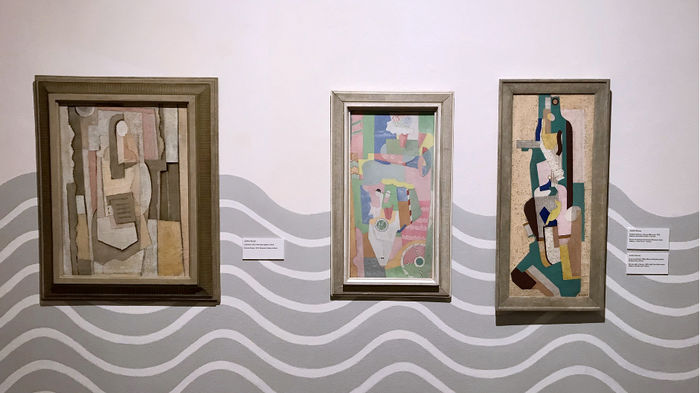Virtual exhibition review: Picasso and Paper at the Royal Academy of Arts
Offering a fresh perspective on a well-known artist, Amber Nip leads us through an exhibition that explores the multifaceted use of paper in the art of Pablo Picasso.
Content Note: This article contains a brief mention of suicide.
How often do we scribble something down and end up throwing away the paper? How often does it then get forgotten about? From tiny sketches and cut-outs of animals to well-known, violently expressive Cubist portraits, the Royal Academy of Arts’ Picasso and Paper exhibition is an ode to the artist’s 80-year career. Immersing the viewer in a sea of endless variation and manipulation of paper, the collection provides an overwhelming insight into Picasso’s creative process with seemingly banal materials: paper, newsprint, wallpaper, and even napkins.
“Paper alone is presented as a means to explore the genius of Picasso’s work”
Having seen many works by this popular artist already, I’m sure I wasn’t alone in wondering how this exhibition could offer anything new, but the RA’s beautiful curation (presented chronologically) promises not to disappoint. Paper alone is presented as a means to explore the genius of Picasso’s work. So, whether you’re an avid fan or only know Picasso for his Cubist manipulation of shapes, this exhibition is a must see.
Almost immediately, we are submerged into the Blue Period – aptly named for its overwhelming sense of loss and melancholy. Placed in the same room as his childhood animal cut-outs, La Vie is an utmost poignant expression. The central male figure is reminiscent of Picasso’s close friend Carlos Casagemas, whose suicide is said to have inspired the Blue Period – his face and body are washed in blue, and set in dramatic juxtaposition to the livelier, childhood studies. In Woman with a Lock of Hair, the tenderness and intensity of the colour palette convey the deeply desolate nature of the room, creating impressions of both gentle sensitivity and misery.
From here we are catapulted into a world of circus dancers and brothels, most notably, Les Demoiselles d’Avignon. This undoubtedly revolutionary painting has been analysed countless times in art classes, but what is most striking to me now is how we are submerged in Picasso’s development process. Whilst this painting is central to the room, the walls are surrounded by sketchbooks and countless paper renderings of the female nude. Study by study, the room becomes an iterative journey of an intensely productive artist.
Picasso’s claim to a friend that ‘the paper seduced me,’ upon procuring a specific Japanese paper, explores the relation between his work and plain materials. There is an intense fascination with scrawled-upon newspaper – doodles, multifaceted collages, and even a paper model depicting a woman’s face (displayed as the exhibition logo). Of particular interest, Head of the Dog is a tiny, crumpled, and burnt napkin that has been suspended in glass; Picasso is even said to have torn the napkin and imprinted its eyes using cigarette butts. Its tiny stature might not make it to typical Picasso exhibitions, but I think that it evokes his very playful expression that borders on humour.
“Sketch by sketch, this unmissable show is a patient and tender tribute to Pablo Picasso’s extraordinary artistry”
Though he retired to France later in life, studios mark the artist’s lively and experimental spirit. Even less focused on realism, he turned to examining his own mortality and conceptions of old age for inspiration. A documentary film by Henry-Georges Clouzot plays alongside this final room, using time-lapse photography to capture the abstraction of line and shape which finally reveal the head of a faun. In just a few minutes, we watch Picasso transform an empty page into a flower, and then a fish, followed by a chicken, followed by a final, haunting depiction of this mythological half human and half goat hybrid. Our final image is therefore this faun’s dark figure, with its wide and vacant red eyes, concluding an impressive and sometimes unusual collection.
Through over 300 generally unknown works, we are invited to reconsider the multifaceted use of paper, a material too often taken for granted. I’ve had the pleasure of visiting this exhibition before its closure; now, after viewing it virtually, I am even more certain of Picasso’s profoundly rich life. In this forty minute virtual tour, we are slowly led through each room and encouraged to dwell on key pieces. Complemented by an apt musical score, we experience the artist’s endless pursuit of imagining and reimagining in such an influx of ideas that they can never all be fully realised. Sketch by sketch, this unmissable show is a patient and tender tribute to Pablo Picasso’s extraordinary artistry.
 News / CUP announces funding scheme for under-represented academics19 December 2025
News / CUP announces funding scheme for under-represented academics19 December 2025 News / Cambridge welcomes UK rejoining the Erasmus scheme20 December 2025
News / Cambridge welcomes UK rejoining the Erasmus scheme20 December 2025 News / SU reluctantly registers controversial women’s soc18 December 2025
News / SU reluctantly registers controversial women’s soc18 December 2025 Film & TV / Timothée Chalamet and the era-fication of film marketing21 December 2025
Film & TV / Timothée Chalamet and the era-fication of film marketing21 December 2025 Features / In-person interviews through student helpers’ eyes20 December 2025
Features / In-person interviews through student helpers’ eyes20 December 2025










